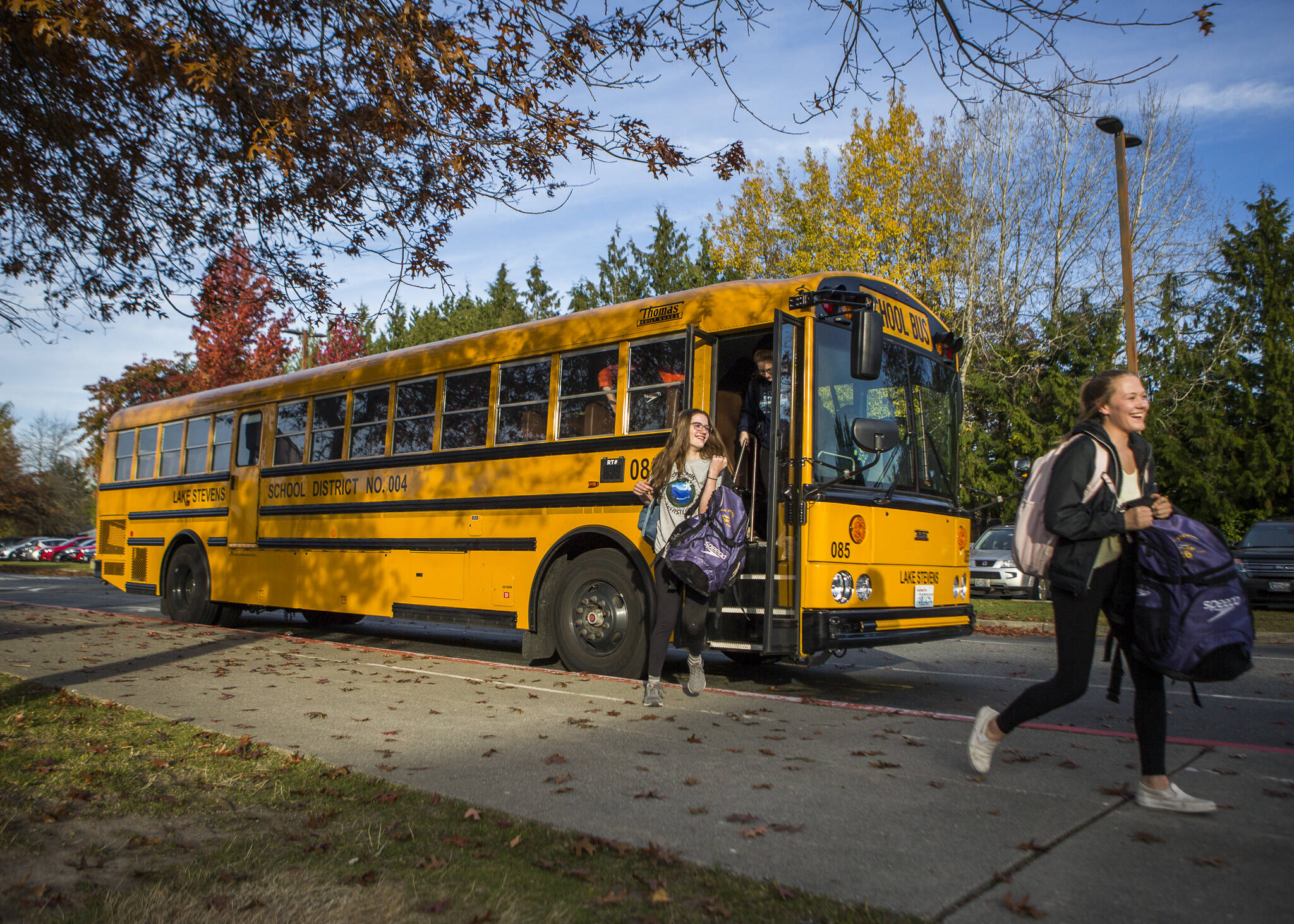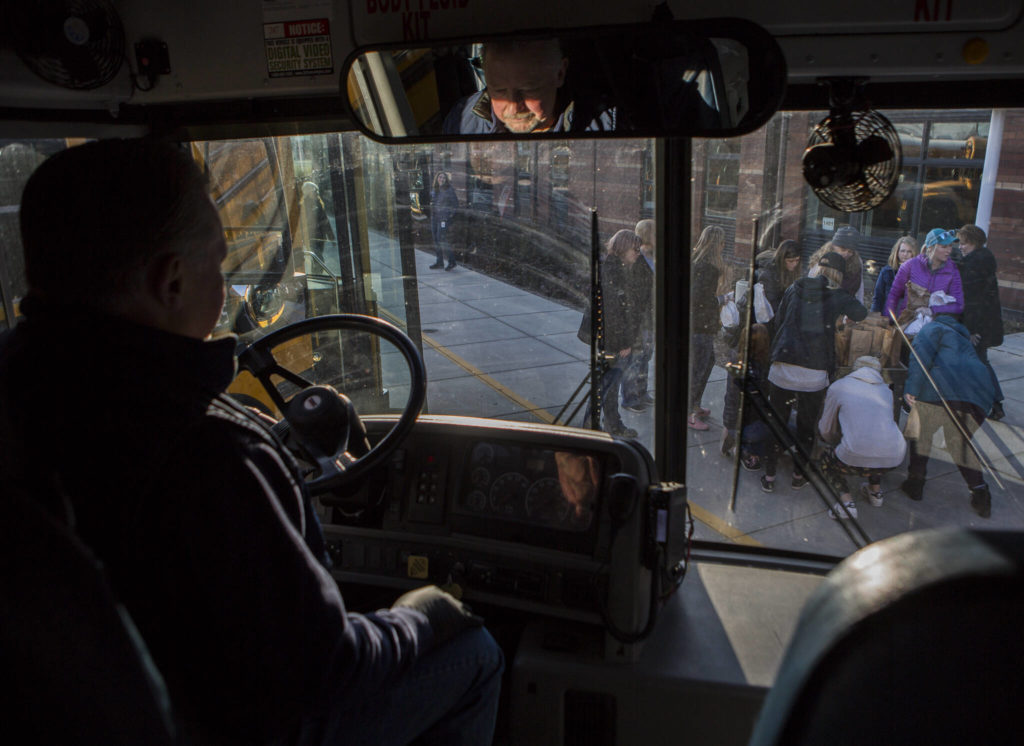MUKILTEO — Lower enrollment. Higher inflation. Inadequate state funding. Loss of federal pandemic aid.
Just one of those would be challenging enough. Together, it’s the perfect storm, said Jon Poolman, director of business services for the Mukilteo School District.
Early estimates indicate the district will need to cut up to 8% of its budget, or $25 million, if conditions hold steady in 2023-24. And Mukilteo is not alone.
Everett Public Schools anticipates a deficit of $25 million to $38 million, or about 7% to 10%. At least two other Snohomish County districts have notified parents of anticipated cuts. Some have held public forums to figure out how best to tighten their belts.
“The degree is a little bit different district to district. Some districts are in better shape than others, because either they haven’t lost enrollment, or maybe they gained enrollment,” said Larry Francois, superintendent for Northwest Educational Service District 189, which supports 35 districts, including all of those in Snohomish County. “I think everyone is feeling the pressure, if not this year, then in the next two to three years.”
Decreased enrollment
A statewide drop of public school enrollment presents one of the biggest threats to budgets right now, because schools in Washington receive funding based on the number of students, Francois said.
The amount per pupil varies based on a complicated formula that considers special education, low-income status and other factors. Some funding is earmarked for special programs only. The state spent an average of $11,500 per student in basic education funding in 2019. On top of that, school districts can apply for state, federal and local grants; receive targeted funding for specific purposes, such as school improvement; or raise local levy funds.
Statewide, enrollment is down nearly 4% compared to before the pandemic.
In Snohomish County, enrollment is down almost 5,000 students from 2019-2020 and 2021-22, according to state data. That’s a loss of about $50 million across 14 districts.
“Districts are still not back to the level of enrollment they were prior to the pandemic, so that puts pressures on budget, because fewer kids (means) lower funding,” Francois said. “And I think districts expected more kids were going to come back last year and this year, and that hasn’t materialized in the way people thought.”
According to Seattle Times reporting, the Bellevue School District plans to consolidate three of seven elementary schools that saw significant enrollment drops. The district expects enrollment to decline further, according to The Times.
In Mukilteo, where the district lost about 630 students, or roughly the equivalent of an entire elementary school, the solution isn’t as simple as closing a building, said Poolman, the business services director.
That’s because the departing students were spread across different grades and different schools. And when a student goes away it doesn’t mean a district is spending $11,500 less, even though it has lost that funding.
“The tricky thing is that you still have to provide a certain level of supervision, instruction, transportation. And it doesn’t necessarily change if you lose three students here, five students there,” said Diane Bradford, district spokesperson in Mukilteo. “Obviously if we don’t have enough students to fill a classroom, we don’t need an extra teacher. But you still need that teacher if you have some kids in that classroom. It’s a delicate balance.”
Lake Stevens is one anomaly. Enrollment is back to pre-pandemic levels — and rising. The district may actually gain state funding.
“We’ve heard people say, ‘We moved to Lake Stevens for your schools. We moved to Lake Stevens for your programs.’ … Other districts haven’t been so fortunate,” said Teresa Main, assistant superintendent of business and operations. “That’s really what’s been keeping us alive.”
The ESSER cliff
Lake Stevens’ challenges revolve around the end of federal COVID relief aid.
Congress doled out $189.5 billion to help the nation’s public schools weather the pandemic. That money, known as ESSER funding, was intended to maintain staff when enrollment nosedived with remote learning, and to support learning recovery when students returned to class.
Roughly $2.6 billion flowed into the state. In total, Snohomish County received about $160 million in ESSER funding, distributed across 14 districts. Schools with higher percentages of low-income families received a larger slice of the money.
ESSER came in three installments, the last of which must be spent by September 2024. After that, the aid faucet shuts off. In a presentation to the school board, Main called the impending end of that funding the “ESSER cliff.”
“There are no replacement funds for any of this resource. That’s why we call it a cliff: It just ends for us,” Main told The Daily Herald in a phone interview.
Lake Stevens received about $8.4 million in ESSER dollars, or about 4.8% of its annual budget. The district spent some of that money on one-time costs, like masks and HVAC upgrades, and some on staffing or programs.
“If we want to continue those programs, we will have to replace them with other resources,” Main said. “Or we will have to reduce those programs or supports.”
Lake Stevens dedicated a portion of the ESSER funds to hiring deans for every elementary school to help boost attendance rates and respond to an increase in student outbursts as kids returned to in-person classes.
Those positions were expressly advertised as two-year gigs, with the possibility to extend if and only if the district found funding, Main said.
Other districts invested in programs they would like to keep.
Everett Public Schools hired more nurses, counselors and paraeducators to help students who struggled with physical and mental health during the pandemic, district spokesperson Kathy Reeves said. Those supports are still needed, Reeves said, so part of the budget “puzzle” is figuring out how to shift funding from other places.
“You can always add more student supports. They are never going to say, ‘Oh we’ve got enough,’” Reeves said. “So if it’s deemed necessary, we will find a way to keep it.”
Snohomish Superintendent Kent Kultgen said his district received about $3.6 million from the federal COVID relief program. That’s roughly 2% of the district’s annual budget — the smallest percentage of any district in the county. Some districts got up to 10% of their annual budgets funded.
“We got very little ESSER funds, which was very difficult meeting the needs of our students when we went online for all that time, or we tried to run an online school and an in-person school at the same time,” Kultgen said. “Our ESSER funds were really stretched thin.”
Inflation and state funding
On the other hand, that means Snohomish is facing a smaller drop in funding now.
The 2023-24 budget will be “tight” but Klutgen said he doesn’t anticipate cuts at this point. There may be a need to dip into the district’s “rainy day” fund to cover a small shortfall, he said. How deep depends on the amount of funding lawmakers decide to send public schools this session.
“Right now it’s looking like the Legislature is doing some good things, but we don’t know until the end,” Kultgen said.
One big question is how much the state’s inflation adjustment will be.
Districts only receive that adjustment on the state-funded part of their budgets. Districts typically provide services, programs and salaries beyond what the state funds, and inflation is driving up those costs.
In Arlington, elementary school counselors serve as a good example of the gaps between state funding and actual staffing, said Gina Zeutenhorst, executive director of finance. The state’s school funding model gives the district about $257,000 for 3.22 full-time counselors. Arlington actually pays $470,000 for four counselors.
If the state provides a boost to keep up with inflation, it would be based on the funding model numbers, Zeutenhorst said.
“And yet we would be obligated to provide that (increase) for all staff in that particular bargaining unit, honoring their fair salaries of keeping and retaining good staff,” she said.
Most districts use local money, raised through educational programs and operations levies, to pay for those differences. Usually, those levies make up 14% to 18% of a district’s annual budget.
But all of those levies rely on voter approval. In recent years, multiple districts in Snohomish County lost a portion of their local funding when voters rejected school tax measures.
‘We’re not rolling backwards’
Yet another headache in the state’s funding approach is what’s known as regionalization, which has steered more state dollars to school districts in areas with a higher cost of living.
Lawmakers added regionalization in 2018, after the McCleary lawsuit overhauled how schools receive state money. Depending on housing prices, districts could receive 0%, 6%, 12%, 18% or 24% more from the state.
The top tier went to districts that lost a significant amount of local funds because of a local levy cap imposed by McCleary. And it came with a caveat: The districts that received it would be weaned down to 18% to rebalance the funding. Between 2018 and 2023, those districts saw a 2-point drop annually.
Everett, Mukilteo, Snohomish, Lake Stevens and Arlington originally qualified for 24% regionalization.
“So instead of getting 24% on top of (the baseline funding), now we are only getting 18%. But of course we’re not rolling backwards when we look at salaries or the cost of anything in today’s world,” said Poolman, the director of business services in Mukilteo.
The regionalization drops effectively counteract any inflation increases the state makes for school funding, Poolman said. So even though the base amount the district receives from the state has gone up, Mukilteo’s total state contribution has “flattened out.”
Although the district knew to expect the regionalization drops, it’s more difficult to balance now, with the other challenges of enrollment, ESSER and inflation, Poolman said.
‘No easy way … to cut millions’
State lawmakers will decide this term whether they want to keep the regionalization model as is, tweak it or start over. Several bills to increase or adjust funding could provide “incremental improvements” and ease some budget stressors for districts expecting challenges, said Francois, the educational services district superintendent.
Those include a measure to increase some staffing ratios and add $25 per student for classroom supplies; a measure to raise the cap on local levies for most districts; two measures to provide free school meals for all students; and several measures that would provide more funding for special education services.
Districts won’t know the exact dollar amount to expect in state funding until lawmakers approve a budget. That’s expected to happen in April. In the meantime, districts expecting multi-million dollar cuts are forming committees and meeting with staff and parents to determine possible ways to reduce expenses.
“I know, from interacting with a lot of superintendents, this is really weighing on them,” Francois said. “These are not easy times. It’s difficult for staff, and no one enjoys going through reductions. … There’s no easy way around trying to cut millions of dollars out of a school district budget.”
Mallory Gruben is a Report for America corps member who writes about education for The Daily Herald.
Mallory Gruben: 425-339-3035; mallory.gruben@heraldnet.com; Twitter: @MalloryGruben.
Talk to us
> Give us your news tips.
> Send us a letter to the editor.
> More Herald contact information.






























